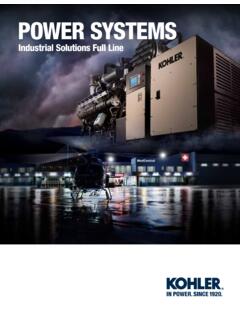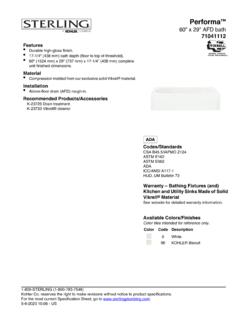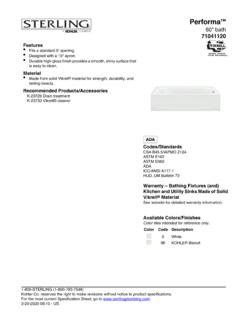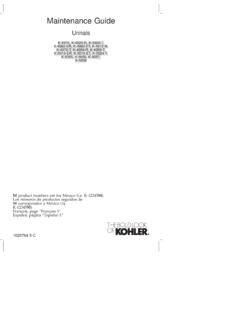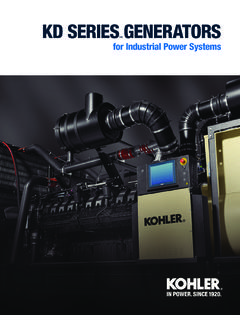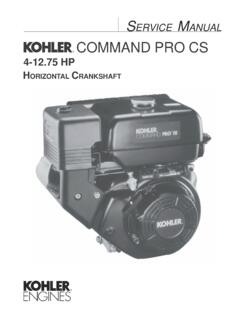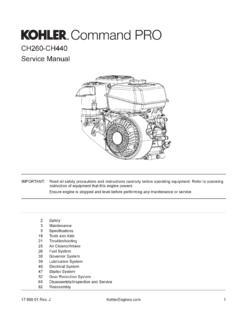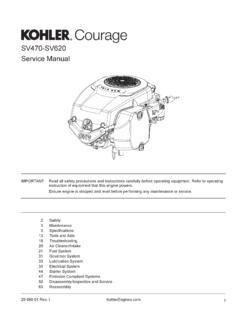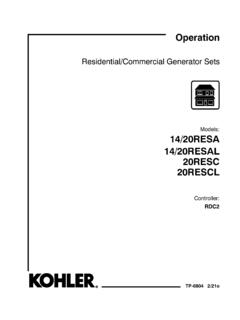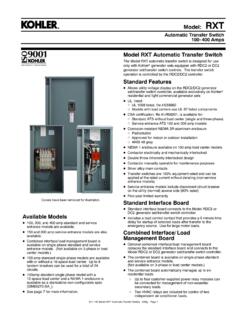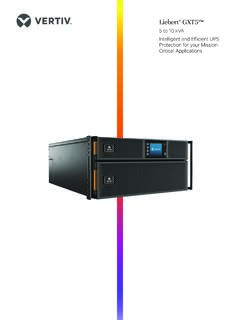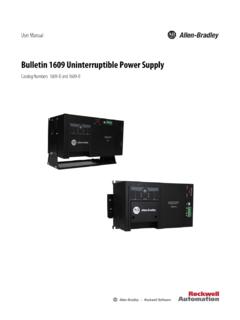Transcription of UNDERSTANDING NFPA 110 - Kohler Co.
1 power SYSTEMS TOPICS 116 UNDERSTANDING nfpa 110: Advice for installing and maintaining emergency power systemsAUTHOR CK power Kohler Authorized Distributor INTRODUCTIONP ower outages can mean more than lights out. For many facilities, an outage of even a minute can result in the loss of millions of dollars or worse, put human lives at risk. National Fire Protection Association standard 110 the standard for emergency and standby power systems outlines requirements for the installation and performance of backup power systems in emergency and legally required applications, where an outage would pose a life-safety risk. In this whitepaper, we ll explore what nfpa 110 is and what to consider when implementing and maintaining your facility s emergency power power supply (EPS) Essentially, the emergency power supply (EPS) is the source of electrical power ( , generator) used in your backup power system ( ).
2 It is independent of your primary source of power , ready to operate in case of power failure. Within the confines of this particular whitepaper, when we refer to an EPS, we are talking about a standby generator. Emergency power supply system (EPSS) Your emergency power supply system (EPSS) refers to your functioning backup power system in its entirety. It includes the EPS, transfer switches, load terminals and all the equipment required to provide a safe and reliable alternative source of power for your facility ( ). WHAT IS nfpa 110: A BRIEF OVERVIEWS plit into eight chapters and three annexes, the 2016 edition of nfpa 110 is intended to codify the performance in installation, maintenance, operation and testing of emergency and standby power systems.
3 Before launching into what nfpa 110 is and how it should and shouldn t be used by facility managers, installers, design engineers and manufacturers, we need to address a few key definitions used throughout the having jurisdiction (AHJ) Authority having jurisdiction (AHJ) is a broad term referring to the agency or agencies responsible for enforcing code compliance in your particular city or region ( ).Approved nfpa 110 defines something as approved when it s acceptable to the AHJ ( ). This is important: the nfpa doesn t approve any equipment or installations as being compliant with nfpa 110 ( ). The only way to guarantee your installation, procedures or equipment are compliant is to work with your AHJ to ensure it aligns with all applicable standards, policies and codes, while referencing this standard and your manufacturer s recommendations.
4 These terms are at the core of nfpa 110. Essentially, the standard provides requirements and best practices for the setup and ongoing performance of EPSSs to ensure they are able to provide prompt and reliable power in the event of the failure of your primary power source, minimizing the risk to human life. 2 / UNDERSTANDING nfpa 110 THE KEYS TO UNDERSTANDING nfpa 110: LEVEL, CLASS AND TYPE The key to UNDERSTANDING the requirements outlined in nfpa 110 lies in acquainting yourself with the way emergency power supply systems (EPSS) are classified: By Level, Class and Type. Level Dictates performance standards your system needs to follow. Class Duration your system must be able to run without refuelingTy pe Time your generator has to be operational after a power failure.
5 These categories dictate decisions including (but not limited to) what equipment to use, where to store the system and how much fuel to keep on site as required by your facility s application, location, proximity to fuel and level of life-safety risk. Level There are two EPSS levels defined in the standard: Level 1 and Level 2. They re distinguished by the types of loads they carry and have different equipment and installation standards. Level 1 EPSS systems provide power where failure would result in loss of human life or serious injuries ( ). Level 2 EPSS systems carry loads less critical to human life and safety ( ). As you can imagine, Level 1 EPSS systems are subject to stricter design guidelines.
6 Most equipment is designed for Level 1 requirements and can be used for the less strictly regulated Level 2 loads. It s important to note that nfpa 110 does not state which applications, specifically, qualify as Level 1 or Level 2 that is up to the AHJs interpretation ( ). They do, however, provide some examples of situations where a Level 1 or 2 EPSS might be required. UNDERSTANDING nfpa 110 / 3 power SYSTEMS TOPICS 116 Possible nfpa 110 Level 1 applications Life safety illumination, public safety communication systems, fire pumps and ventilation equipment ( ). Possible nfpa 110 Level 2 applicationsHeating and refrigeration systems, sewage disposal and some industrial processes ( ).
7 CLASSMINIMUM TIMEC lass hr (5 minutes)Class hr (15 minutes) Class 22 hrClass 66 hrClass 4848 hrClass XOther time, in hours, as required by the application, code or user Source: nfpa 110 Class Your EPSS Class is the duration (in hours) your system must be able to run at its full-rated output without refueling ( ). Class 2 requires your generator run for 2 hours without adding fuel, Class 48 requires 48 hours and so on. Although some AHJs define Class X differently, it generally translates to 96 hours of rated 110 only defines systems with a direct impact on life safety even the failure of a Level 2 system would have significant ramifications for occupants if it failed ( ).
8 Due to the effect of Levels 1 and 2 loads on life safety, nfpa EPSS must be permanently installed to ensure it is available in case of your primary power source s failure. As you re likely aware, there are certain nonessential applications ( , data centers, research facilities) where failure could result in the loss of millions of dollars. These types of loads would be served by optional standby generators, which aren t defined in nfpa 110 because they aren t essential to life safety. Facility managers looking for compliance guidance for a necessary (but not legally required) unit should turn to nfpa 70, more commonly referred to as the National Electrical Code.
9 Article 702 contains helpful information regarding the design and installation of optional standby power systems. Actually, there is quite a bit of overlap between the NEC and nfpa 110. nfpa Level 1 roughly equates to Article 700 for emergency systems, and Level 2 to Article 701 for legally required standby systems. Higher classes pose a challenge for system designers especially designers of larger systems as you must have enough fuel stored on site to satisfy your generator s fuel consumption for the duration as defined by your Class. Let s say you require 18,000 gallons of fuel to run your EPS for 96 hours because you have a Class X EPSS installation. In accordance with nfpa 110, the main fuel tanks have a minimum capacity of 133%, meaning you need to store almost 24,000 gallons on-site.
10 You ll need to carefully size your fuel tanks and perform regular fuel maintenance to ensure compliance ( ). You should also consider fuel supplier delivery logistics if you re in a rural area where it may take more time to get fuel if you run out, you might consider oversizing your tank even further. You should work closely with your generator manufacturer to come up with a fuel storage and maintenance plan that complies with this standard and all applicable codes, without being cost (a) Classification of EPSSs 4 / UNDERSTANDING nfpa 110 DESIGNATIONPOWER RESTORATIONType UBasically uninterruptible (UPS system) Type 1010 sec Type 6060 secType 120120 secType MManual stationary or non automatic-no time limitSource: nfpa 110A FEW IMPORTANT CAVEATS ABOUT nfpa 110 While it provides guidance to design engineers, manufacturers and governing agencies, nfpa 110 is not an all-encompassing manual for the design and implementation of emergency power systems.
